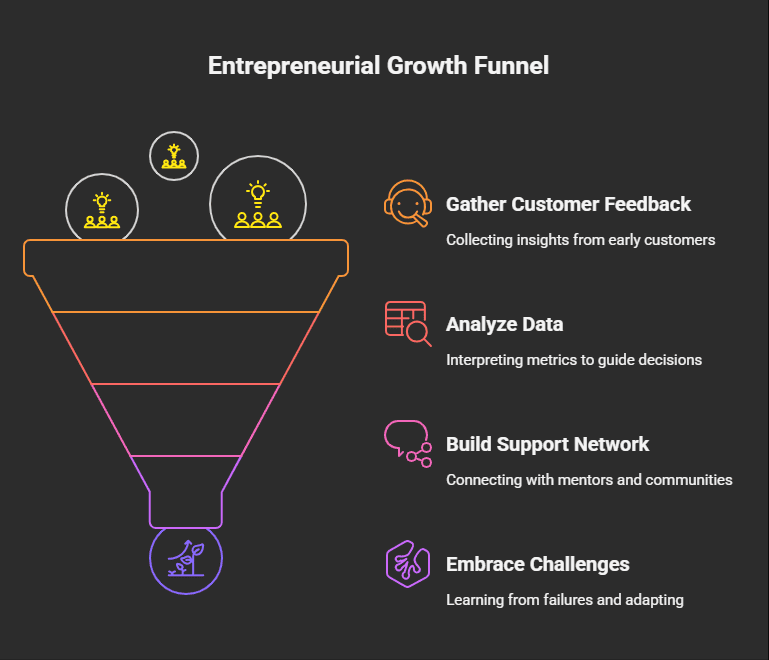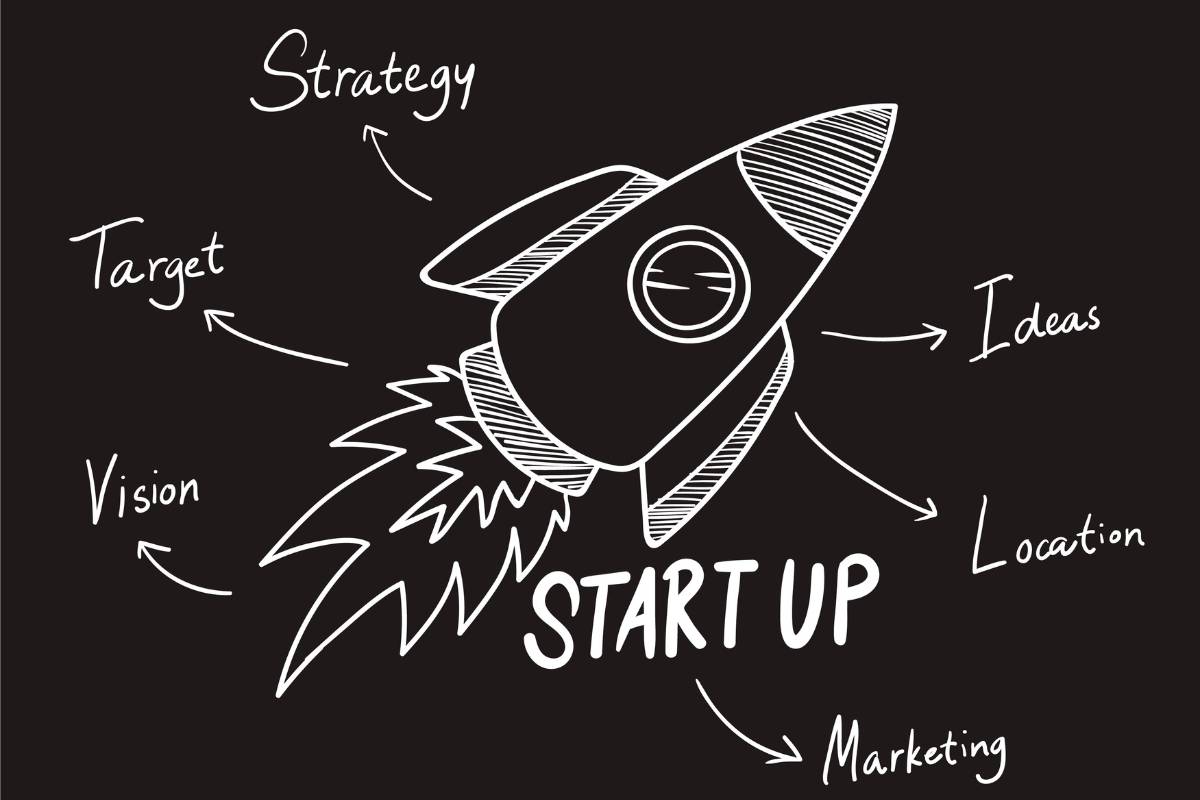So, you’ve got that itch. That little whisper in the back of your mind that won’t shut up, the one that says, “What if?” What if you took that idea, that passion, that nagging problem you know how to solve, and turned it into something real? Something that’s yours.
Believe it or not, that’s how it all starts. Not with a spreadsheet or a venture capitalist on speed dial, but with that persistent, beautiful, terrifying little thought. Welcome to the starting line of your own business. It’s a messy, exhilarating, and frankly, a life-altering journey. And if you’re reading this in 2025, you’re in luck, the tools and possibilities at your disposal have never been more potent.
But where do you even begin? It can feel like standing at the base of a mountain shrouded in fog. You know the summit is up there somewhere, but the path is… well, it’s not exactly clear, is it?
That’s what this guide is for.
So grab a coffee. Get comfortable. Let’s talk about building your dream, one step at a time.
Step 1: The Idea and The “Why” – More Than Just a Lightbulb Moment
Everyone thinks you need a world-shattering, never-before-seen idea to start a business. A true lightning-in-a-bottle moment. If I’m honest? That’s mostly a myth.
Sure, some businesses are born from pure, unadulterated genius. But most, and I mean most, successful businesses come from something far more relatable:
- Solving a problem you know intimately. Think about Adi Dassler, the founder of Adidas. He wasn’t trying to invent fashion; he was a shoemaker who listened intently to athletes, obsessing over their needs and pain points. He wanted to build a better shoe for them. What’s a frustrating process in your life? A product that almost works, but not quite? A service that makes you want to tear your hair out? Right there, that’s fertile ground.
- Putting a new spin on an old tune. You don’t have to reinvent the wheel. Just make it roll smoother. Look at the explosion of subscription boxes. We’ve always bought coffee, pet supplies, and makeup. But delivering a curated experience to someone’s door? That was a fresh take. What’s an existing industry you could inject with more convenience, better design, a stronger sense of community, or a more sustainable approach? The trends for 2025 are screaming for this: hyper-personalization, eco-conscious everything, and tech-driven convenience.
- Turning your passion into a paycheck. This one’s tricky, but oh-so-rewarding when it works. Are you the person everyone comes to for baking advice? The one who can fix any computer? The one who crafts beautiful pottery on weekends? These skills, these passions… they have value. The key is figuring out how to package that value in a way people will pay for.
Here’s the kicker, though: Your idea is only half the equation. The other half, the one that will fuel you through the inevitable late nights and moments of doubt, is your why.
Why this business? Why now? Why are you the one to do it?
Is it to gain freedom and flexibility? To build something lasting for your family? To make a tangible impact on your community? To prove to yourself you can?
Your “why” is your anchor. When the seas get rough, and they will, it’s what will keep you from drifting. Write it down. Stick it on your wall. Never forget it.
Step 2: The Reality Check – Is This Thing Viable?
Okay, you’ve got your idea and your why. You’re buzzing. The world looks full of possibilities.
Now, we need to bring that idea down from the clouds and see if it can walk on solid ground. This is the market research phase, and I know, it sounds about as exciting as watching paint dry. But trust me, skipping this step is like trying to build a house without checking the foundation. It’s a recipe for disaster.
Here’s how to make it suck less, and actually be… fun?
- Become a detective. Your mission, should you choose to accept it, is to understand your future customers better than they understand themselves. Who are they? What do they really want? Where do they hang out online? What are they complaining about on forums, in Facebook groups, or in product reviews for your potential competitors? These are pure gold.
- Talk to actual humans. Seriously. Surveys and data are great, but nothing beats a real conversation. Find five people who you think would be your ideal customer. Offer to buy them a coffee (or jump on a quick video call) and just listen. Ask them about their struggles related to your idea. Don’t pitch them. Just listen. You’ll learn more in 30 minutes than you will in three days of Googling.
- Scope out the competition. Who’s already out there trying to solve this problem? Don’t get discouraged if you find competitors. Competition is a good thing! It validates that there’s a market. Now, put on your spy glasses. What are they doing well? What are their customers complaining about? (Hello, opportunity!) How are they pricing their products? What’s their brand vibe? Your goal isn’t to copy them, but to find the gaps they’ve left for you to fill.
Funny thing is, this stage often reshapes your initial idea. And that’s a good thing! It’s like sculpting. You start with a block of marble, and you slowly chip away until the real form emerges. By the time you’re done with your research, your idea will be stronger, sharper, and have a much, much better chance of survival.
Step 3: The Blueprint – Your Not-So-Scary Business Plan
Ah, the dreaded business plan. The thing that makes most aspiring entrepreneurs want to run for the hills. We picture a 100-page, leather-bound tome filled with impenetrable jargon and financial charts that look like a foreign language.
Let’s reframe this.
Your business plan is not a homework assignment. It’s your roadmap. It’s the story of your business, where you are, where you’re going, and how you’re going to get there. And in 2025, it doesn’t need to be a novel. In fact, a lean, one-page plan is often more powerful.
Here are the essential chapters of your story:
- Executive Summary: Write this last. It’s the trailer for your movie, a quick, punchy overview of everything that follows.
- Company Description: What’s your mission? What are your core values? What makes your business tick? This is where your “why” gets to shine.
- The Problem & Your Solution: Clearly state the pain point you identified in your research. Then, introduce your product or service as the hero that saves the day. How do you make life better for your customers?
- Market Analysis: Who’s your target customer? (You know this from Step 2!) What does the competitive landscape look like? What makes you different and better?
- Marketing & Sales Plan: This is crucial. How will people find out you exist? Will it be through the community-building power of social media? The targeted precision of digital ads? The slow, steady burn of content marketing and SEO? Maybe it’s old-school flyers and local events. There’s no single right answer, but you need an answer.
- The Financials (Don’t Panic!): This is where people get sweaty palms. Let’s simplify. You just need some educated guesses.
- Startup Costs: What will it take to open your doors (real or virtual)? List everything: website hosting, inventory, business registration, software, a new laptop.
- Pricing: How much will you charge? (Your competitor research will help here.)
- Projections: A simple forecast. How much do you realistically think you can sell in your first three months? Your first year? Be optimistic, but keep your feet on the ground.
This plan isn’t set in stone. It’s a living document. It will change. But the act of creating it forces you to think through the critical pieces of your business puzzle. It turns a fuzzy dream into an actionable strategy.
Step 4: Making It Official
This part can feel a bit like navigating a bureaucratic maze, but it’s a non-negotiable step that protects both you and your business. The specifics can vary quite a bit depending on where you live (I’m in Kerala, India, so the process here involves things like Director Identification Numbers and GST registration), but the core concepts are universal.
- Choose Your Business Structure: This is a big one. Are you a sole proprietorship (just you, simple to set up, but your personal assets aren’t separate from the business)? A partnership (you and one or more others)? Or maybe a Limited Liability Company (LLC) or a Private Limited Company, which offer more protection for your personal assets? Each has its own tax and legal implications. If I’m being totally honest, this is one area where it might be worth chatting with a local accountant or legal professional. A little bit of money spent here can save you a world of headaches later.
- Register Your Business Name: You’ve got a killer name, right? Make sure it’s not already taken! Then, register it. This might involve a “Doing Business As” (DBA) filing or a formal registration with your state or country.
- Get the Right Licenses and Permits: Depending on your industry and location, you might need specific licenses to operate legally. A food business will have different requirements than an e-commerce store or a consulting firm. A quick search on your local government’s website should point you in the right direction.
- Open a Business Bank Account: Do not, I repeat, DO NOT, mix your personal and business finances. It’s a bookkeeping nightmare and can get you into hot water legally. Open a separate bank account for your business from day one. It’s a simple act that signals you’re serious and makes tracking your income and expenses infinitely easier.
Yes, it’s paperwork. It’s not the glamorous part of entrepreneurship. But getting this stuff right from the start builds a solid, professional foundation for everything to come. Do it right, do it once.
Step 5: Show Me the Money! – Funding Your Dream
This is the question on everyone’s mind, isn’t it? How do I pay for all this?
The good news is, in 2025, there are more funding avenues than ever before. The bad news? You still have to do the work to get it.
Let’s break down the most common options:
- Bootstrapping (The DIY Route): This is where you fund the business yourself, using your own savings. The major pro? You answer to no one. You own 100% of your company. The con? Your growth is limited by your own bank account. But you know what? So many incredible businesses started this way. It forces you to be scrappy, creative, and incredibly focused on generating revenue from day one.
- Friends & Family: This can be a wonderful source of seed money. They believe in you! But a word of caution: treat it like a formal business transaction. Put everything in writing. A loan agreement, an equity stake, whatever the terms are. Don’t let money ruin a relationship.
- Small Business Loans: This is the traditional route. Banks and other financial institutions offer loans, but they’ll want to see that business plan you wrote (see, I told you it was important!). In India, for example, there are fantastic government schemes like the Pradhan Mantri Mudra Yojana (PMMY) specifically designed to help small entrepreneurs. Look into what your local government offers!
- Crowdfunding: Platforms like Kickstarter and Indiegogo allow you to pre-sell your product or offer rewards in exchange for funding from the public. It’s an amazing way to validate your idea and build a community before you even launch.
- Angel Investors & Venture Capital (The Big Leagues): This is what you see in the movies. Wealthy individuals (angels) or firms (VCs) who invest large sums of money in exchange for a stake in your company. This is typically for businesses with high-growth potential. It’s a whole different ballgame, be prepared for a rigorous pitching process and giving up a significant chunk of your ownership.
Which path is right for you? It depends entirely on your business, your goals, and your risk tolerance. Don’t be afraid to start small. A business that makes a profit, no matter how small, is a successful business.
Step 6: Building Your Brand & Your Digital Home
Your business exists! It’s legal, it has a bank account, and you have a plan. Now, how do you present it to the world? This is where we get into branding and building your online presence. And let me tell you, this is where the magic happens.
Your brand is so much more than a logo. It’s a feeling. It’s the promise you make to your customers. It’s what they think of when they hear your name.
- Craft Your Brand Identity:
- Your Story: Why do you exist? What do you believe in? People connect with stories, not with corporations. Share your journey. Be authentic.
- Your Voice: Are you playful and witty? Professional and authoritative? Warm and empathetic? Define your personality and use it consistently everywhere.
- Your Visuals: Now we get to the fun stuff, your logo, your color palette, your fonts. These are the visual cues that make your brand instantly recognizable. In 2025, clean, adaptable design is key. Your logo needs to look as good on a tiny phone screen as it does on a billboard.
Once you have your brand identity, it’s time to build your digital storefront.
- Your Website is Your Castle: Even if you sell primarily on social media, you need a website. It’s the one piece of online real estate you truly own. It’s your central hub for information, your blog, and your e-commerce store. Platforms like Shopify, Squarespace, and Wix have made it incredibly easy to build a stunning, professional website without knowing a lick of code.
- Choose Your Social Media Battlefield: You don’t need to be on every single platform. That’s a one-way ticket to burnout. Go where your target audience is. Are they visual and creative? Instagram and Pinterest might be your jam. Are they professionals? LinkedIn is a must. Is your audience into fast-paced, entertaining video? Hello, TikTok. Pick one or two platforms and dominate them. Post consistently, engage with your followers, and show the human side of your brand.
- The Power of Content: This is the heart of modern marketing. Create content that is genuinely helpful, entertaining, or inspiring to your audience. Blog posts, video tutorials, behind-the-scenes glimpses, helpful guides… this is how you build trust and position yourself as an expert. It’s a long game, but the payoff is a loyal community that will champion your brand.
Your online presence is your 24/7 salesperson. Make it welcoming, make it interesting, and most importantly, make it a true reflection of the amazing business you’re building.
Step 7: The Launch & The Never-Ending Journey of Growth
The day has come. You’re ready to flip the switch and go live.
It’s terrifying. It’s thrilling.
A launch doesn’t have to be a massive, fireworks-and-confetti event. It can be a “soft launch” to a small group of people to get feedback. It can be a simple announcement to your email list and social media followers.
The most important thing is to just… start.

And then? Then the real work begins. Because starting a business isn’t a destination; it’s the beginning of a new journey.
- Listen, Learn, Adapt: Your first customers are your greatest source of wisdom. Listen to their feedback, the good, the bad, and the ugly. What do they love? What’s confusing? What do they wish you offered? Be prepared to pivot and adapt. The business you end up with might look quite different from the one you started with, and that is more than okay.
- Track Everything (The Simple Way): Keep an eye on your numbers. How many visitors are coming to your site? How many are buying? What are your most popular products? Which marketing channels are actually working? This data is your guide. It tells you what to do more of and what to stop wasting your time on.
- Don’t Do It Alone: The entrepreneurial journey can be lonely. Find your people. Join online communities of other business owners. Find a mentor. Build a support network. Celebrating the wins and navigating the losses is so much better when you have people in your corner.
- Embrace the Mess: Things will go wrong. You will make mistakes. You will have days where you question everything. It’s part of the process. Bill Gates’ first company, Traf-O-Data, was a failure. Steve Jobs was famously fired from Apple. Failure isn’t the opposite of success; it’s a stepping stone on the path to success.
The Final Word
Building a business is not for the faint of heart. It will demand more of you than you ever thought possible. It will test your resilience, your creativity, and your sanity.
But it will also give you something unparalleled. A sense of purpose. The pride of creating something from nothing. The freedom to build a life on your own terms.
That little whisper in your head? It’s not going away. And in 2025, with the world at your fingertips, there has never been a better time to listen to it.
So take that first step. Write down that idea. Talk to that first potential customer. Draft that one-page plan.
Now, go get started.








